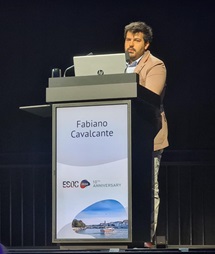
Intravenous thrombolysis (IVT) prior to a mechanical thrombectomy procedure appears to be less effective in ischaemic stroke patients with carotid-artery tandem lesions, as compared to in patients without tandem lesions, according to the findings of a MR CLEAN-NO IV subanalysis presented at the recent European Stroke Organisation Conference (ESOC; 15–17 May, Basel, Switzerland).
Delivering these results, Fabiano Cavalcante (Amsterdam University Medical Centers, Amsterdam, The Netherlands) was quick to emphasise that the present findings apply to patients presenting directly to a comprehensive stroke centre (CSC) capable of administering thrombectomy treatments. He also reported similar rates of intracranial haemorrhage (ICH) across patients with and without tandem lesions, effectively refuting the causal pathway investigators had hypothesised for a difference in treatment effect and meaning they “cannot explain” the contrasting functional outcomes between the two groups.
The MR CLEAN-NO IV trial—originally published in 2021—enrolled patients in Belgium, France and The Netherlands, with the goal of evaluating stroke thrombectomy with versus without prior intravenous thrombolysis (IVT), and ultimately found ‘direct thrombectomy’ approaches without IVT to be neither superior nor non-inferior to thrombectomy with IVT. Here, Cavalcante noted that this finding was in line with multiple other trials investigating the same issue.
“Perhaps the solution to this problem lies in patient selection,” he continued. “Patients presenting early appear to benefit from IVT and also, possibly, patients with tandem lesions could [experience] a different effect of IVT. These patients represent about 15% of all those undergoing endovascular treatment and are thus a clinically relevant population. Currently, they should be treated with IVT and [thrombectomy]—if eligible—but, more frequently, are also treated for their underlying tandem lesion during the endovascular procedure itself, either with or without acute stenting, and that raises questions about the efficacy and safety of IVT for this specific population.”
Against this backdrop, Cavalcante and his colleagues conducted a subanalysis of MR CLEAN-NO IV including patients with tandem lesions in their carotid arteries—a population that accounted for 17% of the 539 patients enrolled in the original trial. Regarding baseline differences, he relayed that patients with tandem lesions were found to be more likely to have large-artery atherosclerosis as an aetiology, better collateral scores, worse functional outcomes on the modified Rankin scale (mRS), and any ICH, compared to non-tandem lesion patients.
Intention-to-treat analyses of the study’s primary endpoint—90-day ordinal shift in mRS scores—revealed that stroke patients without tandem lesions who were treated with IVT prior to thrombectomy experienced “slightly better functional outcomes” compared to those who did not receive IVT; an observation “in line” with the effect of IVT in the overall population of MR CLEAN-NO IV, according to Cavalcante. However, tandem-lesion patients experienced worse functional outcomes when treated with IVT versus without, and a statistically significant difference was observed here (p=0.02).
“We see similar results when we analyse the rate of patients with excellent functional outcomes [mRS 0–1], and the rate of patients with good functional outcomes [mRS 0–2] as well,” Cavalcante reported. “And, we see a similar trend in the opposite direction when we assess the rate of patients having a poor functional outcome or mortality—but, importantly, we do not see an increase in the rate of symptomatic ICH, which was our primary hypothesis to explain a difference in treatment effect […] in this population. Thus, the mechanism behind this treatment-effect heterogeneity remains unclear.”
Before closing his presentation, Cavalcante disclosed several study limitations, with the first being the ‘secondary’ nature of this analysis. Furthermore, he noted, data from three trials also investigating the effect of thrombectomy with or without IVT in tandem lesions—DIRECT-MT, DIRECT-SAFE and SWIFT DIRECT—have not replicated these findings. In addition, the analysis was “underpowered” to draw specific conclusions on the treatment effect of angioplasty or acute stenting, and MR CLEAN-NO IV only enrolled patients treated with alteplase, making it impossible to make any inferences regarding alternative IVT drugs like tenecteplase.
“In conclusion, for patients who present directly to centres capable of providing endovascular treatment, IVT before [thrombectomy] was less effective in patients with tandem lesions, and more effective in patients without tandem lesions,” Cavalcante said. “This interaction and [treatment]-effect modification has limited credibility, so we believe that should be taken into consideration [and the results] should be interpreted carefully.”









